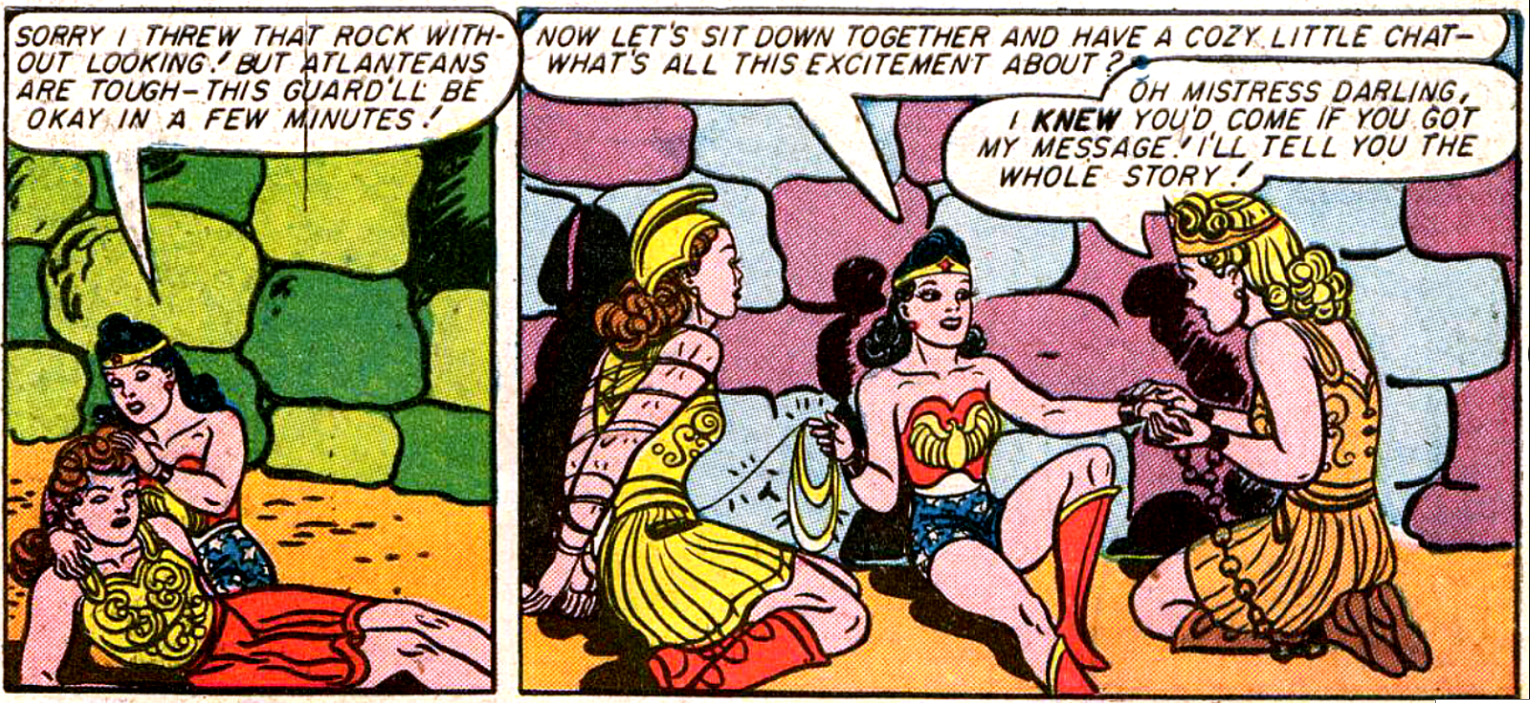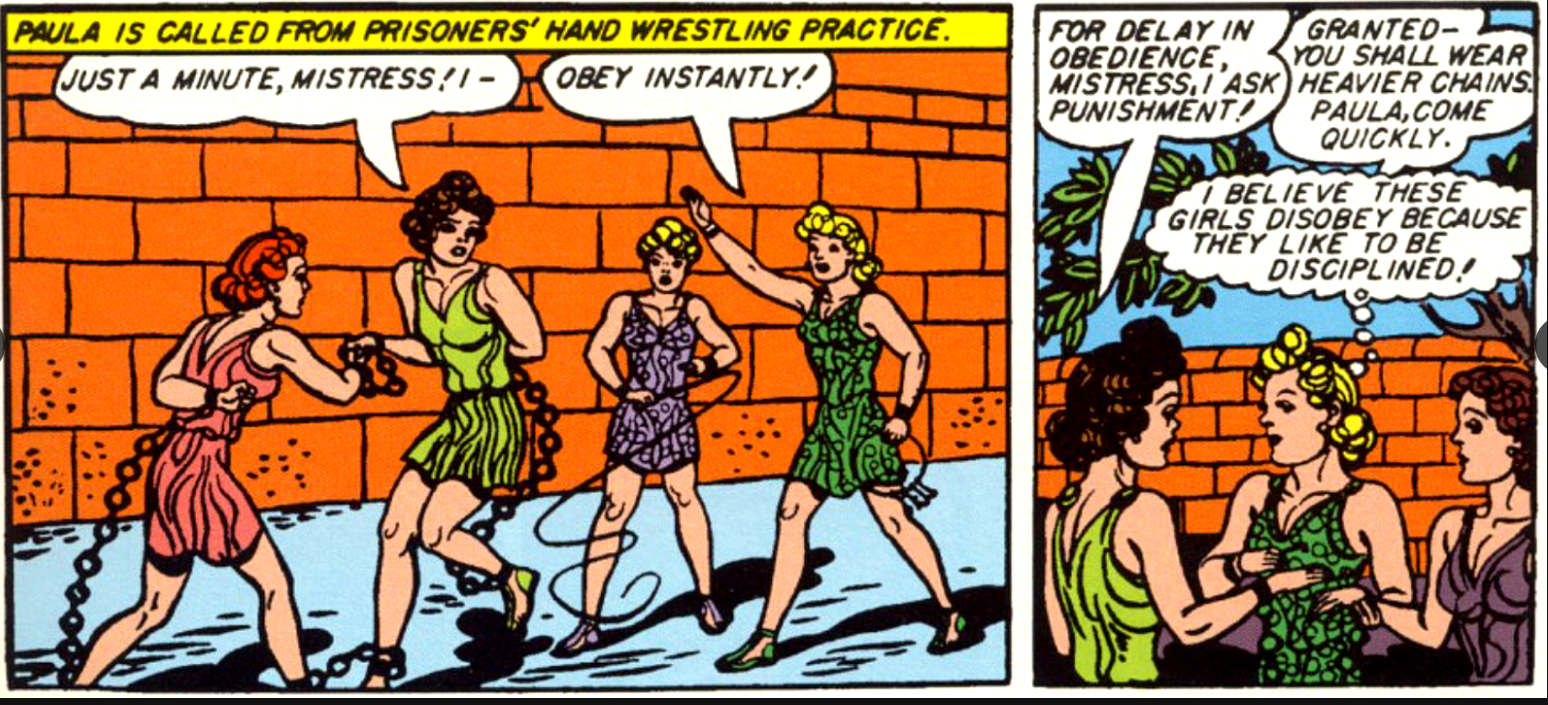Wonder Woman and Her Bondage Roots
By now, anyone who has ever been a fan of DC Comics is aware that early Wonder Woman comics had some bondage themes. This was largely, in part, due to Wonder Woman creator, William Marston’s BDSM and polyamory lifestyle.
The Ancient History of Bondage and Discipline
BDSM has been practiced in various forms since ancient times. One of the earliest known references to the practice of bondage is The Tomb of Whipping near Tarquinia in Italy. The tomb’s walls depict scenes, said to have been influenced by followers of the Greek god Dionysus. One of those scenes painted on the wall is the depiction of two men flogging a woman who stands between them, bent over, grabbing the hips of one, possibly performing fellatio as the other stands behind her.
In Sparta, 9th century BC, young men were gathered and whipped by priestesses in a ritual called diamastigosis in one of the cult rituals that was alleged to have made the men strong. It makes sense for the Amazonian women who fled ancient Greece to have these same traditions. In addition to the physical portrayals of Bondage, Discipline, Dominance and Submission, Sadomasochism, most historians forget to include the one thing that made BDSM so vital then and today still, and especially with regard to Wonder Woman.
The Link Between Truth, Sex, and Wonder Woman
In ancient Greece, truth and sex were linked, in the form of pedagogy, by the transmission of a precious knowledge from one body to another; sex served as a medium for initiations into learning.
This is one of the primary reasons Wonder Woman’s main weapon is the golden Lasso of Truth. Marston, a Harvard graduate, psychologist and inventor of the polygraph lie detector test, understood the importance of the character he was creating in his particular era of 1941. Wonder Woman, for Marston, was a symbol of everything our society lacked then: free love and equality for women.
Bondage as Protest and Feminist Symbolism
Marston was in school during the Suffragette Movement, where women, borrowing from the abolitionist movement, chained themselves to the gates of the White House in protest for the right to vote. In this way, every time Wonder Woman was tied up or chained, this symbolized her need to escape men’s power over her. In the comics, she is often referred to as Mistress and for another to dominate her is a power struggle that she always wins. And to this, Marston believed that:
The only hope for peace is to teach people who are full of pep and unbound force to enjoy being bound... Only when the control of self by others is more pleasant than the unbound assertion of self in human relationships can we hope for a stable, peaceful human society... Giving to others, being controlled by them, submitting to other people cannot possibly be enjoyable without a strong erotic element.
This idea of loving submission remains a key tenet of modern BDSM. A submissive who gives up control willingly is powerful because the act is a choice.
Wonder Woman’s Return to Bondage Roots in Earth One
Though, feminists today who have very little knowledge of Wonder Woman from the Golden Age of comics tended to turn their nose up and feel offense over the Wonder Woman Earth One graphic novel series. Grant Morrison and Yanick Paquette wanted to return Wonder Woman to her bondage roots in their 2016 Earth One series.
The Earth One series, unfortunately, was the first time in decades that the Wonder Woman stories actually worked (it still had its problems, but that’s for another time). Why? Because Wonder Woman’s costume and bondage go hand in hand. As mentioned earlier, she uses the Lasso of Truth to bound her foes, which makes them tell the truth—they submit to her. Her bracelets are a defense against bullets but look like wrist shackles. So, when the Comics Code Authority of 1954 decided to ban “horror, excessive bloodshed, gory or gruesome crimes, depravity, lust, sadism, and masochism” and directly addressing Wonder Woman, saying “Illicit sex relations are neither to be hinted at nor portrayed. Violent love scenes, as well as sexual abnormalities, are unacceptable” the stories just didn’t seem to recover. Though, DC tried.
Why Wonder Woman Needs Her BDSM Roots to Thrive
Deviating from Wonder Woman’s BDSM past is part of the reason her storylines just haven’t been as good as it was during the Golden Age of comics. If DC can reconcile the feminist icon with her BDSM roots, Wonder Woman could finally reach her full potential. She could be what she was meant to be.
How do you view the themes of Golden Age Wonder Woman?
Frequently Asked Questions About Wonder Woman’s Bondage Roots
Why did early Wonder Woman comics feature bondage themes?
Early Wonder Woman comics reflected creator William Moulton Marston’s interest in BDSM, truth, and feminism. Bondage symbolized both erotic power dynamics and women’s resistance against male dominance.
What does Wonder Woman’s Lasso of Truth symbolize?
The Lasso of Truth connects to Marston’s background as the inventor of the lie detector. It reflects the Greek tradition of linking truth, sex, and knowledge, showing that submission to truth is a form of power.
How did the Comics Code Authority affect Wonder Woman?
In 1954, the Comics Code banned depictions of sadomasochism and “sexual abnormalities.” Wonder Woman lost much of her original symbolism and her storylines weakened as a result.
Why do some feminists reject Wonder Woman’s bondage themes?
Some modern readers see bondage as conflicting with feminism. However, in the Golden Age, bondage symbolized women breaking free from patriarchal control and reclaiming power.
What was the significance of Wonder Woman: Earth One?
The 2016 Earth One graphic novel by Grant Morrison and Yanick Paquette revived Wonder Woman’s bondage roots. While controversial, it reconnected the character to the deeper symbolism of truth, submission, and dominance.


